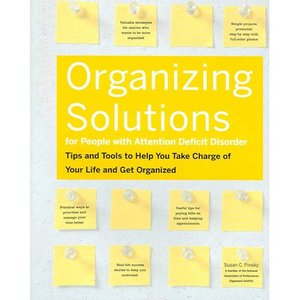You probably already know that disorganization is one of the many symptoms for those diagnosed with ADD. I do not have anyone in my immediate family diagnosed with ADD, but as an elementary school teacher I worked with many students with ADD who also struggled with disorganization.
This month’s read shows that doesn’t always have to be the case! With accommodations made for those with ADD, in or out of the classroom, organization can be improved.
Organizing Solutions for People With Attention Deficit Disorder by Susan C. Pinsky, describes that many conventional organizing strategies will not work for someone with ADD. The organizing solutions in this book focus on creating simple “one-step tasks” to keep things in order. Aesthetics is no longer the priority and functionality becomes the main concern.
For instance, you shouldn’t have to do any “rummaging or shifting” to remove or replace an item. Do away with lids, have open shelving, and install lots of hooks in order to give one less step for clean-up.
After a quick introduction, each of the book’s chapters focus on an area of the home plus one chapter on scheduling/time management. Additionally, each page is dedicated to a specific problem within an area of the home which makes this a great resource book. One of my favorite chapters was focused on children’s rooms. As the author explains, “Reducing steps and materials is even more important for children than adults.”
Read it:
If you are living with someone diagnosed with ADD, this would be a must read. The simple “tips and tools” are a different way to think about organization. The home needs to be set up in such a way that a task can be completed before distraction hits.
Even though I was reading Organizing Solutions for People With Attention Deficit Disorder mainly to expand my knowledge of organizing for others, I connected with the overarching theme that spaces do not have to look pretty all of the time. A space should be functional and efficient. When things do become messy (because they will), the mess “will be only one layer deep, and you’ll know how to fix it.”
Skip it:
If you are looking for design or decor ideas, this is not the book for you. The pictures are cut and dry and feature everyday items. No fancy staging here!
Favorite excerpt:
One of the largest barriers to getting rid of things is having an agenda for every item in your home. The decision to keep things for future use or resale value earns you little but the weighty burden of micromanagement. Although it seems financially responsible, it will probably instead cost you an organized and stress-free home. If you find yourself hesitating to get rid of something because you are holding on to it for your sister, waiting to get it appraised by a knowledgeable Hummel dealer, or planning to put it on eBay (after you get your digital camera fixed), then you are making it too complicated to reduce the inventory in your home.
Favorite tip:
After reducing your spice inventory “loosely alphabetize the remaining spices.” I love that word “loosely!” I might just start using it for everything around the house. Loosely fold the clothes, loosely sweep the floors, etc.
Do you have experience with helping someone (or yourself) with ADD get organized? What has worked for you?


Awesome! About time there was a book about this. My 15yo has ADHD and while it’s pretty much under control for the most part it’s the organisation that really suffers and drives the rest of us (including the school) completely mad.
Will be putting this on my shopping list and will be getting my son to read it too!
This book is just what I need! I am a very organised person, but I am married to a wonderful guys who has ADHD. Sometimes he drives me nuts with his lack of organisation, I know it’s not his fault. This book is definatly going to a a must read, maybe then we can implement some strategies that are going to work for both of us not just me.
Great! I’d love to hear what you both think about the book and what tips you ending up implementing. I found the tips to be accessible and super user friendly. I’ll definitely be implementing some of them!
having someone around during the organizational process helps. The person doesnt have to “chip in” and physically help, but having them there to redirect me when i lose focus helps a ton.
My ADD is now the reason for my love of organization. I posted a little something on organizing for the visual person, which most ADD people are. http://thedistractedblogger.wordpress.com/2011/08/09/36/
One of the best tips for those with ADD or those bring up a child with ADD make sure it is comfortable to ask for help. I struggled with this one a lot, still do sometimes. Nikki is right, sometimes just having someone there to redirect or just keep the mood light is important since people with ADD can get frustrated quickly.
So true about making sure children feel okay to ask for help. Thanks for sharing your post about ADD. What great tips!